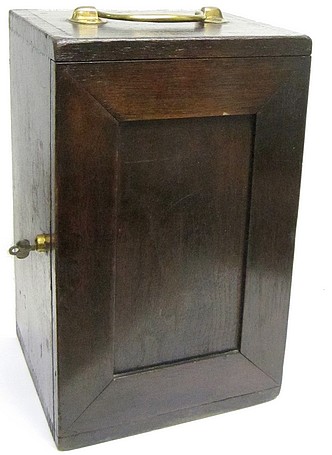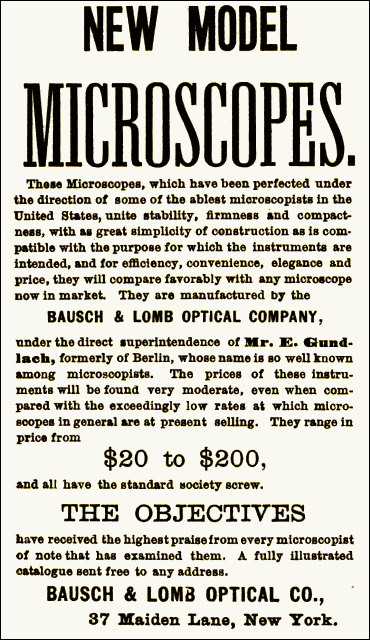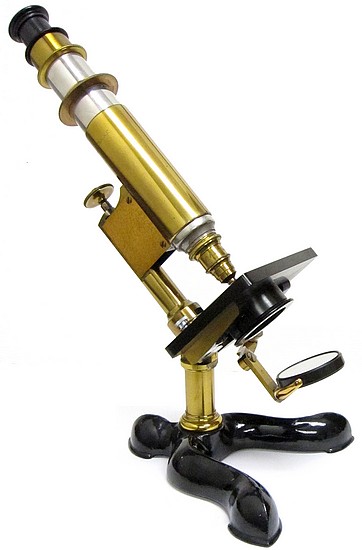
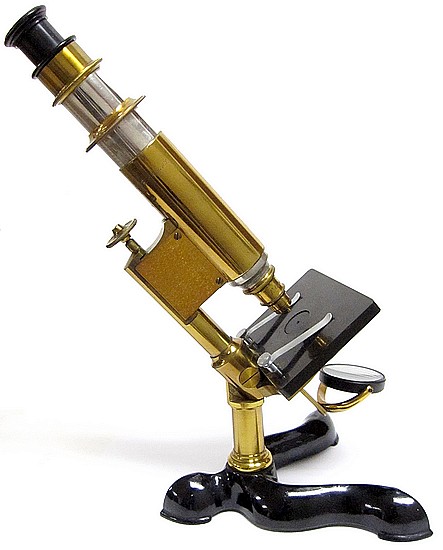
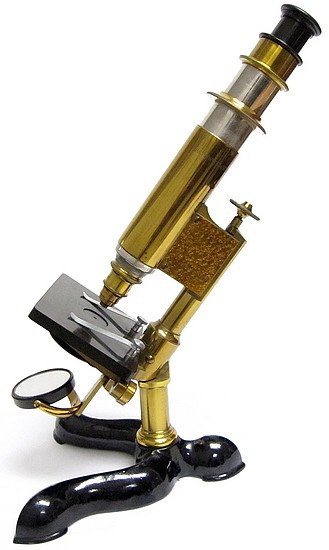
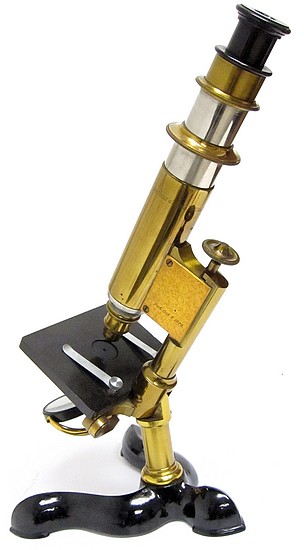
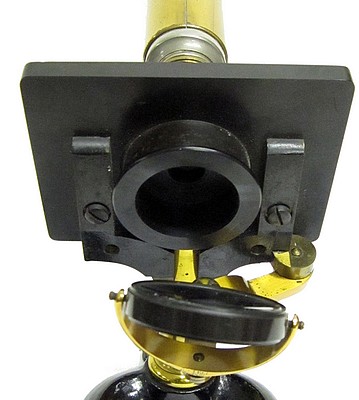
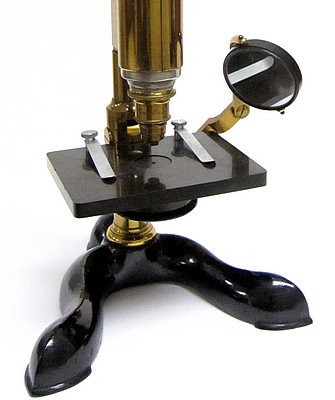
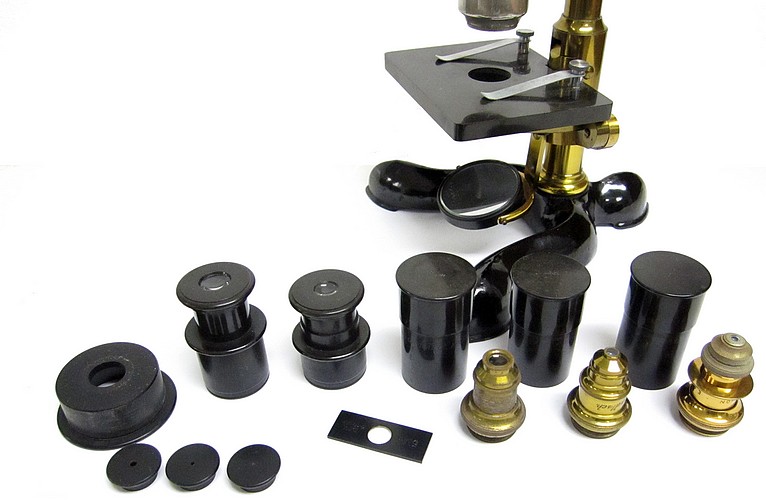
The accessories include three objectives (3/4, 1/5, and 1/8 immersion) signed E.Gundlach, each with a hard rubber canister, two eyepieces made of hard rubber labeled A and C, a hard rubber aperture stop holder with three stops, and an eyepiece micrometer that fits the C eyepiece. The stage is also made of hard rubber, as is the mirror housing.
This microscope was designed and made by Ernst Gundlach while employed by Bausch & Lomb. Initially, Gundlach manufactured microscopes in his own establishment in Berlin. He sold his workshop there and then emigrated to America in 1871 where he started off producing microscope objectives. In 1876, he was hired by Bausch & Lomb to head their newly established microscope business. It was during this time that the microscope shown on this page was produced. By the end of 1879, he was no longer in the employment of B&L, but instead, he started his own ventures in microscope production.
One aspect of this microscope, which is characteristic of the earliest microscopes produced by the Bausch & Lomb firm, was the extensive use of hard rubber to fabricate the components of the microscope stand and its optics. This was a holdover from the firm's earlier production of hard rubber eyeglass frames. Ultimately, these hard rubber components proved not to be very durable and were replaced with those made of brass. The microscope shown here is rather rare, being in production for only about two years. Two versions of this model were produced, one which remains upright and one which can be inclined. The microscope shown here is an example of the latter version. Remarkably, it appears to be in nearly unused condition.
The following descriptions were extracted from the Aloe & Hernstein's Illustrated Catalogue, 1879
540: LABORATORY MICROSCOPE: Large heavy cast Iron foot carrying a strong solid brass pillar, to which the body stage and mirror motion is attached; draw tube allowing 2 1/2 inch shortening; coarse adjustment by sliding tube; fine adjustment by our new patent frictionless motion; large hard rubber stage, resting upon two brass arms; spherically formed revolving diaphragm under the stage, fixed in such a manner as to be very close to the object slide; plain and concave mirror arranged so that their distance from the object may be varied. These mirrors may also be brought to any obliquity or above the stage for opaque objects; two eye-pieces, A and C; two objectives 2/3 inch and 1/5 inch magnifying powers, when the tubes are completely drawn out, from 50 to 375 diameters; eye-piece micrometer. This instrument is intended especially for student's work in histological laboratories. In its general construction, therefore, it has been simplified to the last degree, so as to the cost as much as possible; the quality of the optical part has been fully maintained and the objectives will compare favorably with the general run of first-class lenses. In upright walnut case with handle, lock, and drawer for accessories. -------- $50.00
545: INCLINING LABORATORY MICROSCOPE: The same stand as No 540, except that the pillar is provided with a strong joint, which allows the body to incline to any angle (shown by cut No. 560); the revolving diaphragm is also replaced by a sub-stage of standard size, in which slides a ring carrying one of three different sized diaphragms, which when pushed up, will closely reach the object slide, (Hartnack's cylinder diaphragm). This Instrument has the same optical parts as No. 540, and camera Lucida, in upright walnut case, with handle, lock and key, and drawer for accessories. ----- $55.00
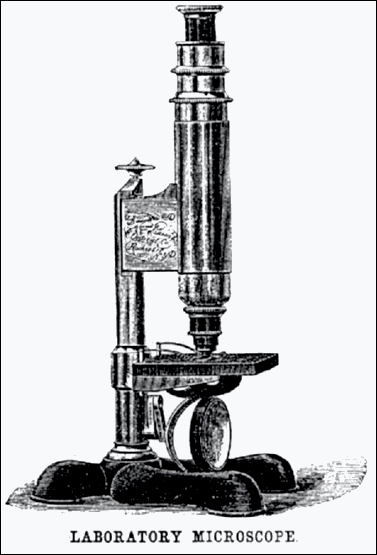
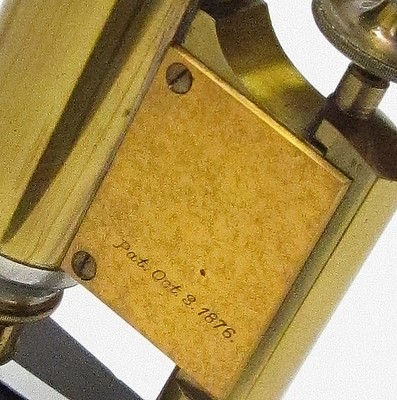
The patent of Oct. 3, 1876 describes the fine adjustment mechanism used on this microscope designed by E. Gundlach
